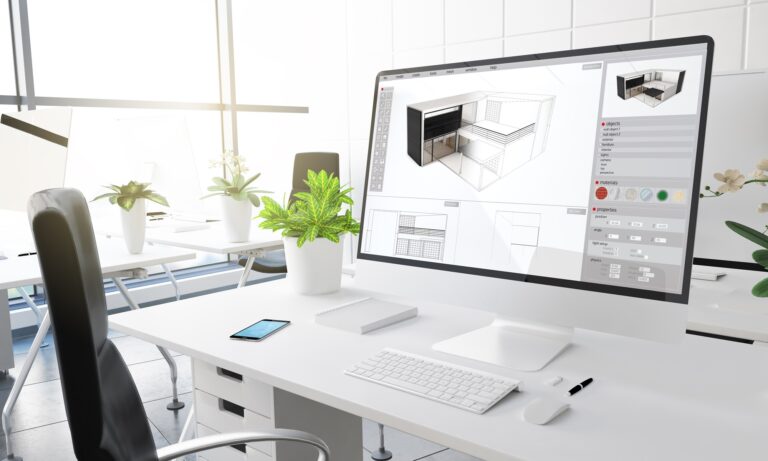Finding the right tools to support your interior design business can feel overwhelming. You need software for design work, project management, finances, and more. Houzz Pro and Studio Designer can help meet these needs, even though their features vary significantly.
Let’s compare both to help you decide whether one of these programs or an alternative might be right for your business.
Table of Contents
What are the main differences between Houzz Pro and Studio Designer?
Houzz Pro and Studio Designer differ in two main categories: features and client base.
Houzz Pro is an all-in-one tool for designers that supports design work, project management, finances, and marketing. It’s built for interior designers, architects, and contractors.
Studio Designer doesn’t have design or marketing tools, but it does offer features for project management and accounting/finances. It’s made for interior designers specifically.
Houzz Pro VS Studio Designer: Features
Houzz Pro’s main features include:
- Floor planning, mood boards, and photorealistic rendering
- Web clipper tool
- Visual project tracker and schedule tool
- Client dashboard and collaboration features
- E-signatures and approvals
- Change order forms
- Invoicing and online payment processor
- Quickbooks integration
- Financial reports with time and expense trackers
- Marketing perks, including a custom website, targeted ads, and lead generation
Studio Designer is used for accounting and project management. Its main features include:
- Sourcing and procurement tools
- Branded client documents and a portal for online payments, document sharing, and approvals
- Detailed financial reports, including design-specific forms
- Accrual accounting
- Overhead and expense tracker
- Cash flow and tax calculations
- Accounts receivable and accounts payable
- General ledger, where proposals, invoices, and payments are recorded automatically
Houzz Pro VS Studio Designer: Pricing
Houzz Pro now offers three plans, each designed to fit different business needs. Pricing starts at $249 per year for the Pro plan, which includes essential tools like estimates, invoicing, a 3D floor planner, online payments, and more.
For firms that need more advanced capabilities, Custom and Enterprise plans are available. Pricing isn’t published online. These plans include features like AI-powered estimates and schedules, takeoffs, project schedules, and priority support. Pricing for Custom and Enterprise plans is available upon request.
A free trial is available for new users.
Studio Designer is priced per user and offers three main plans (billed monthly or annually):
- Essentials – $72/month per user. Basic project management and accounting features.
- Enterprise – $84/month per user. Advanced features with more customization and support.
- Premier – $109/month per user. Includes high-touch service and full access to all features.
Discounts are available for annual billing.
Houzz Pro VS Studio Designer: Online Reviews
Houzz Pro has 4.3/5 stars and 1.074 reviews on Capterra. On G2, it has 3.8/5 stars and 15 reviews.
Studio Designer has 3.3/5 stars and 3 reviews on Capterra. It currently has no reviews on G2.
Houzz Pro VS Studio Designer: Customer Support
Houzz Pro’s customer support includes live, on-demand training sessions, an online help center filled with how-to guides and video tutorials, and a pro forum for gathering advice from other subscribers. The Houzz Pro app also has a built-in chat feature for quick access to customer service representatives.
Studio Designer has an online help center filled with articles, guides, and videos. For more personalized training, users can attend weekly webinars and expert-led courses. Enterprise and Premier accounts have access to live chat and phone calls, but Starter and Essentials-level subscribers don’t have access to human support.
Which platform should you choose?
Houzz Pro may be the right fit if you:
- Want to avoid signing up for multiple software subscriptions
- Work with contractors regularly
- Need built-in marketing tools
- Don’t want to pay more for each team member
Studio Designer may be the better option if you:
- Prefer the built-in accounting method
- Own a large firm requiring detailed financial reports
- Already have a design software you know and love
Frequently asked questions
Studio Designer’s plans are more affordable than Houzz Pro’s. However, there are a few factors to keep in mind when comparing costs. To start, Houzz Pro charges additional users $60 each, instead of the full monthly subscription price per seat. Studio Designer charges the full price per seat. So if you have a large team, Houzz Pro could be more affordable, but if you have a small team, Studio Designer is probably more affordable.
It’s also important to consider the cost of the features that each tool lacks. For example, Studio Designer may be cheaper for a single user, but it will also require additional software for floor planning and 3D rendering. Houzz Pro includes these features and may be similarly-priced to paying for Studio Designer on top of the cost of another subscription.
If neither tool feels right, check out this guide to finding the right design business software. You may be able to find a different tool that checks all of your boxes, price point included.
Studio Designer is preferred for interior design firms. Not only is the software built specifically for designers, but its detailed financial features may eliminate the need for outside accounting services.
If you like the project management features but don’t necessarily need in-depth accounting, check out these alternative project management tools.
Houzz Pro is better for contractors thanks to its inclusion of construction-specific features like change order forms. It’s also designed for use in multiple industries, unlike Studio Designer, which is built specifically for interior designers.
Houzz Pro can be a more budget-friendly option for teams since it doesn’t charge per user on every plan. Studio Designer, however, uses a per-user pricing model, so costs can add up as your team grows. That said, Studio Designer’s higher-tier plans do offer more granular control over user permissions.
Studio Designer shines when it comes to accounting and financial reporting—it includes features like accrual accounting, cash flow tracking, and a general ledger. Houzz Pro keeps things simpler with invoicing, estimates, and QuickBooks integration, but it’s not designed to replace full accounting software.
Both platforms allow some level of customization. Studio Designer lets you brand invoices and proposals, while Houzz Pro offers visuals like 3D floor plans and project timelines. However, if you’re looking for fully customizable design presentations or branded deliverables, those capabilities are somewhat limited in both.
Studio Designer can take a bit more time to learn, especially if you’re not already comfortable with accounting tools. Houzz Pro is a little more intuitive but still has a lot of features to navigate. Both offer tutorials and help centers to guide you, but it may take a little patience to get fully comfortable.
Houzz Pro includes tools like moodboards, online payments, and client-facing dashboards that can support an e-design workflow. Studio Designer, on the other hand, doesn’t include features built specifically for remote or digital design services. If e-design is a big part of your business, a platform like DesignFiles—created with that model in mind—may be a better fit.
The ideal all-in-one software for solo designers and small firms
Houzz Pro and Studio Designer have fairly specific client bases, so they aren’t going to be a good fit for every interior designer. If you’re seeking alternatives, we recommend DesignFiles. As an all-in-one business software built specifically for solo designers and small firms,
DesignFiles offers:
- Mood boards, floor planner, and 3D renders
- Built-in, customizable product library
- Browser extension product clipper
- Ability to shop items and add affiliate links
- SideDoor integration
- Spec/FFE schedules
- Project calendars
- Task management
- Time tracker
- Presentation slide decks
- Digital contract creation and sending/signing
- Customizable questionnaires
- Client portal for document sharing, feedback, and payments
- Team collaboration capabilities (including project-side discussions with clients and team members)
- Ability to sell online design packages
- Branded PDFs for client presentations
- Quotes, invoices, and the ability to accept online payments
- Basic financial reports and Quickbooks integration
DesignFiles has 4.4 stars on Capterra and 4.5 on G2. Customer support includes an online library of video tutorials and articles, live training and webinars, human-based chat, and an expansive user community to gather advice from.
Prices are also lower than Houzz Pro’s and Studio Designer’s. Plans start at $49 per month for e-designers and $69 per month for full-service business owners.
Are you ready to learn more? Sign up for a trial account today. Your first project is free.
![Top 7 Interior Design Project Management Software [2026 Guide]](https://blog.designfiles.co/wp-content/uploads/2024/06/AdobeStock_215623020-768x512.jpeg)

